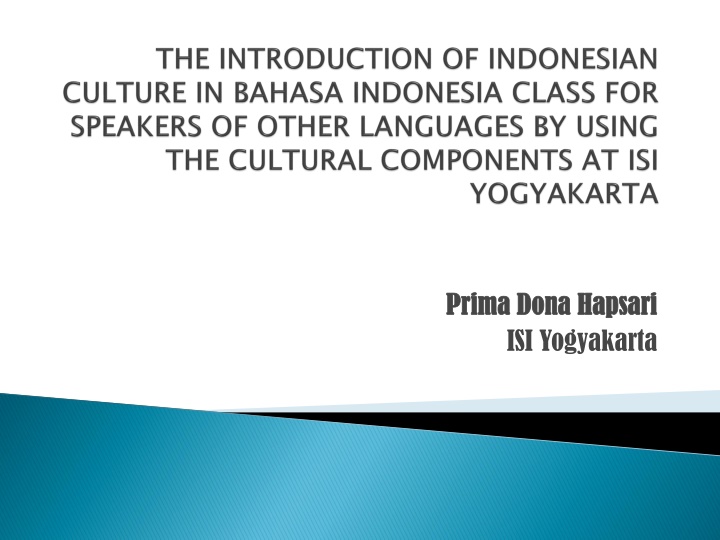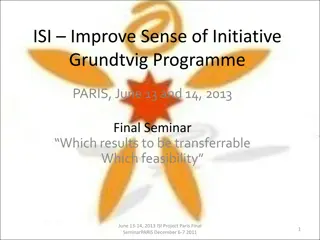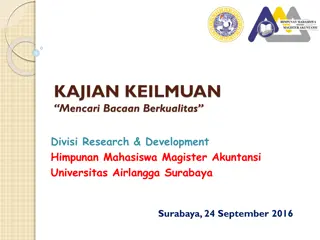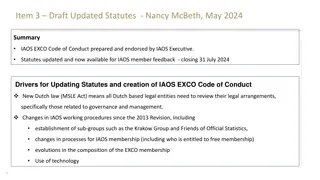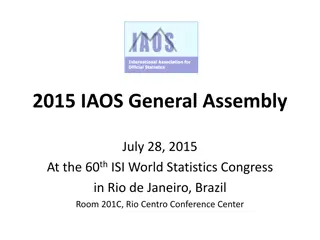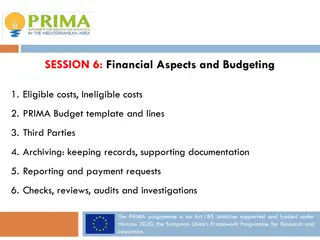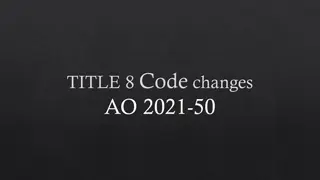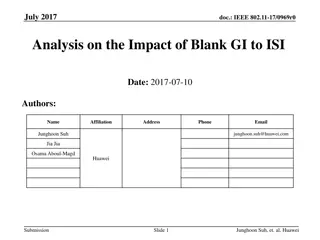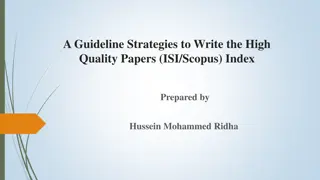Prima Dona Prima Dona Hapsari ISI Yogyakarta Hapsari
Learning Bahasa Indonesia and Indonesian culture is crucial for understanding diverse perspectives, values, and norms. Cultural components in Bahasa Indonesia classes help convey important values and foster adaptation to new cultural settings. Language acquisition aids in cultural understanding, mitigating potential cultural shock through stages of acculturation.
Download Presentation

Please find below an Image/Link to download the presentation.
The content on the website is provided AS IS for your information and personal use only. It may not be sold, licensed, or shared on other websites without obtaining consent from the author.If you encounter any issues during the download, it is possible that the publisher has removed the file from their server.
You are allowed to download the files provided on this website for personal or commercial use, subject to the condition that they are used lawfully. All files are the property of their respective owners.
The content on the website is provided AS IS for your information and personal use only. It may not be sold, licensed, or shared on other websites without obtaining consent from the author.
E N D
Presentation Transcript
Prima Dona Prima Dona Hapsari ISI Yogyakarta Hapsari
Learning Bahasa Indonesia and Indonesian culture for speakers of other languages has been tremendously increasing nowadays. The supposed to have good adaptation to any different points of view, background, social life, language and culture, and so forth. The government has launched the program to help countries in learning bahasa Indonesia as well as Indonesian culture. speakers of other languages are and facilitate learners from other
How to Introduce and Convey the Cultural Components in Bahasa Indonesia Class. How to Give the Learners Important Values toward the Indonesian Characteristics through the Process of Learning Bahasa Indonesia and Indonesian Culture.
A. Culture and Language Culture is defined as a system of symbols that allows us to represent and communicate our experience (Spradley and McCurdy, 2006). Culture is transmitted via our symbolic communication system that we call language (Bates and Fratkin, 2003). Cultural knowledge is not only transmitted through the language, but it is also produced by the language.
Knowing the language helps people to understand the culture better. A cultural shock might happen where the language, culture, customs, and beliefs are different to their own. It is a feeling of disorientation of someone who may experience when thrust into an unfamiliar cultural setting (Bates and Fratkin, 2003).
Brown (1987) says that culture shock is one of the four successive stages of acculturation: 1. the period of excitement and euphoria over the newness of the surroundings, 2. culture shock emerges as individuals feel the intrusion of more and more cultural differences into their own images of self and security, 3. recovery in which culture stress comes up, 4. acceptance of the new culture and self-confidence that has developed in the culture
The teaching and learning process in BIPA class should be supported by teachers accommodation, techniques, and methods. The teacher should have critical thinking and point of view that the speakers of other languages are not different but they have their own perspectives, symbols, interpretations, values, and feelings of belonging to their country.
Bundhowi (2007) says that culture cannot be taught, but what teachers are supposed to do is trying to build the Indonesian culture awareness. Teaching methods on cultural components introduced to speakers of other languages who learn Bahasa Indonesia: 1. Knowledge about Indonesia 2. Cultural Notes 3. Cultural Discussion 4. Cultural Research
1. How to Introduce and Convey the Cultural Components in Bahasa Indonesia Class. BIPA aims to accommodate and facilitate the foreign people who study at ISI Yogyakarta for the short-term program or for the exchange program between two universities to know and understand bahasa Indonesia and Indonesian culture.
BIPA at ISI Yogyakarta provides syllabus and teaching materials in which they can accommodate the learners need to understand and know bahasa Indonesia as well as Indonesian culture. Some cultural components used in BIPA class are knowledge about Indonesia, cultural notes, and cultural discussion.
2. How to Give the Learners Important Values toward the Indonesian Characteristics through the Process of Learning Bahasa Indonesia and Indonesian Culture Brown (1987) proposes ten principles of language learning or teaching which can be used to give the learners important values characteristics through the process of learning Bahasa Indonesia and Indonesian Culture: 1. to lower inhibitions in which teachers can involve their learners to play guessing and communication games; do role-plays and skits; sing songs; use group work; laugh together and share fears in small groups. toward the Indonesian
2. to encourage risk taking - teachers praise leaners for making efforts to try out language; use fluency exercises where errors are not corrected at that time; give outside- of-class assignments to speak or write or otherwise try out the language. 3. to build learners self-confidence - teachers should tell the learners verbally and non-verbally that teachers believe in them; have them make lists of their strengths, of what they know or have accomplished in the course. 4. to help learners develop intrinsic motivation - teachers can tell them about the natural beauty of Indonesia, thousands of ethnic groups living in Indonesia, pluralistic society, etc.
5. to promote cooperative learning - teachers can do that by directing learners to share their knowledge and culture; playing down competition among them; getting the class to think of themselves as a team; and doing a considerable amount of small-group work. 6. to encourage leaners to use right-brain processing - teachers should use movies and tapes in class; have the learners read passages rapidly; do skimming exercises; do rapid free writes ; do oral fluency exercises where the object is to get learners to talk (or write) a lot without being corrected. 7. to promote ambiguity tolerance - teachers should encourage learners to ask question to teachers and each other what they do not understand something; keep their theoretical explanations very simple and brief; deal with just a few rules at a time.
8. to help learners use their intuition - teachers should help them to use their intuition by praising them for good guessing; not giving explanation of errors let a correction suffice; and correcting the selected errors, preferably just those that interfere with learning. 9. to get learners make their mistakes work for them - teachers should tape-record learners oral production and get them to identify errors; let them catch and correct each other s errors; not give them the correct form; encourage them to make lists of their common errors and to work on them on their own. 10. to get learners get their own goals - teachers should encourage or direct learners to go beyond the classroom goals; have them make lists of what they will accomplish on their own in a particular week; get the learners to make specific time commitments to study the language; and give extra credit work.
The class is divided into 2 classes, elementary and intermediate the pre-test The program is conducted for 16 meetings. During the program, questionnaire and interview are carried out to analyze the program and get data. The tests * pre-test and post test * mid-term test and final test
CONCLUSION CONCLUSION 1. BIPA is assumed as a potential program for foreign people who want to learn and understand bahasa Indonesia and Indonesian culture. By following the BIPA class, the speakers of other languages are actively engaged with Indonesian culture. 2. The cultural components are regarded to bring positive values and significant changes to the learners understanding on Indonesia and its culture.
